
Hans Christian Andersen was a Danish author. Although a prolific writer of plays, travelogues, novels, and poems, he is best remembered for his literary fairy tales.

Jean Pierre Carl Buron, known professionally as Jean Hersholt, was a Danish-American actor. He is most famous for starring on the CBS radio series Dr. Christian from 1937–1954, which later inspired a TV series with the same name from 1956-1957. He also co-starred with Shirley Temple in the film Heidi (1937). When asked how to pronounce his name, he told The Literary Digest, "in English her'sholt; in Danish, hairs'hult." From 1924 to 1955, he had 140 motion picture credits: 75 silent film and 65 "talkies"; he directed four.
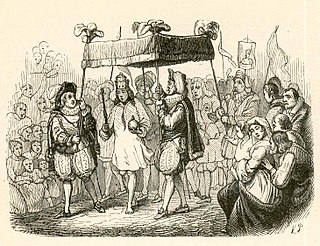
"The Emperor's New Clothes" is a literary folktale written by the Danish author Hans Christian Andersen, about a vain emperor who gets exposed before his subjects. The tale has been translated into over 100 languages.

"The Little Mermaid", sometimes translated in English as "The Little Sea Maid", is a fairy tale written by Danish author Hans Christian Andersen. Originally published in 1837 as part of a collection of fairy tales for children, the story follows the journey of a young mermaid princess who is willing to give up her life in the sea as a mermaid to gain a human soul.
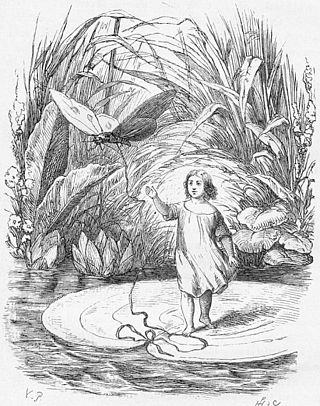
Thumbelina is a literary fairy tale written by the famous Danish author, Hans Christian Andersen. It was first published by C. A. Reitzel on 16 December 1835 in Copenhagen, Denmark, with "The Naughty Boy" and "The Travelling Companion" in the second installment of Fairy Tales Told for Children. Thumbelina is about a tiny girl and her adventures with marriage-minded toads, moles, and cockchafers. She successfully avoids their intentions before falling in love with a flower-fairy prince just her size.

"The Princess and the Pea" is a literary fairy tale by Hans Christian Andersen about a princess who is tested to become the wife to a lonely prince. The tale was first published with three others by Andersen in a cheap booklet on 8 May 1835 in Copenhagen by C. A. Reitzel.
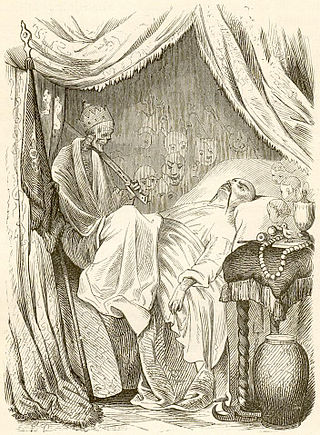
"The Nightingale" is a literary fairy tale written by Danish author Hans Christian Andersen. Set in ancient China, the story recounts the friendship between the Emperor and a nightingale.

"The Twelve Dancing Princesses" is a German fairy tale collected by the Brothers Grimm and published in Grimm's Fairy Tales in 1815. It is of Aarne-Thompson type 306.

"The Swineherd" is a literary fairy tale by Hans Christian Andersen about a prince who disguises himself as a swineherd to win an arrogant princess. The tale was first published December 20, 1841 by C. A. Reitzel in Copenhagen, Denmark in Fairy Tales Told for Children. New Collection. Third Booklet. The tale appears to be original with Andersen though similar tales are known. "The Swineherd" has been adapted to other media.

"The Red Shoes" is a literary fairy tale by Danish poet and author Hans Christian Andersen first published by C.A. Reitzel in Copenhagen 7 April 1845 in New Fairy Tales. First Volume. Third Collection. Other tales in the volume include "The Elf Mound" (Elverhøi), "The Jumpers" (Springfyrene), "The Shepherdess and the Chimney Sweep", and "Holger Danske".
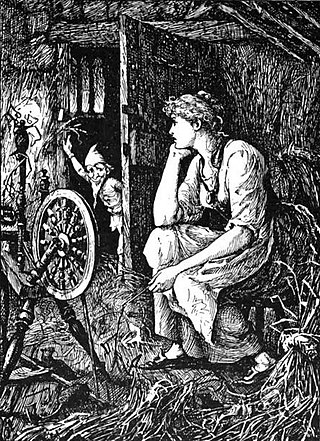
The Langs' Fairy Books are a series of 25 collections of true and fictional stories for children published between 1889 and 1913 by Andrew Lang and his wife, Leonora Blanche Alleyne. The best known books of the series are the 12 collections of fairy tales also known as Andrew Lang's "Coloured" Fairy Books or Andrew Lang's Fairy Books of Many Colors. In all, the volumes feature 798 stories, besides the 153 poems in The Blue Poetry Book.
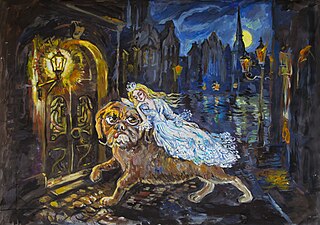
"The Tinderbox" is a literary fairy tale by Hans Christian Andersen about a soldier who acquires a magic tinderbox capable of summoning three powerful dogs to do his bidding. When the soldier has one of the dogs transport a sleeping princess to his room, he is sentenced to death but cunningly summons the dogs to save his life.
"The Silent Princess" is a Turkish fairy tale, structured as a frame story with three inserted tales: "The Magic Pomegranate" ; "The Carpenter, the Tailor, and the Clergyman"; "Three Suitors at the Graveyard". Andrew Lang included it in The Olive Fairy Book.

"The Goblin at the Grocer's" is a fairy tale published in 1852 by Danish author Hans Christian Andersen, about a goblin who must choose between poetry or his Christmas porridge from a grocer.

"The Flying Trunk" is a literary fairy tale by the Danish poet and author Hans Christian Andersen about a young man who has a flying trunk that carries him to Turkey where he visits the Sultan's daughter. The tale was first published 1839.
"The Most Incredible Thing" is the final literary fairy tale by Danish poet and author Hans Christian Andersen (1805–1875). The story is about a contest to find the most incredible thing and the wondrous consequences when the winner is chosen. The tale was first published in an English translation by Horace Scudder, an American correspondent of Andersen's, in the United States in September 1870 before being published in the original Danish in Denmark in October 1870. "The Most Incredible Thing" was the first of Andersen's tales to be published in Denmark during World War II. Andersen considered the tale one of his best.
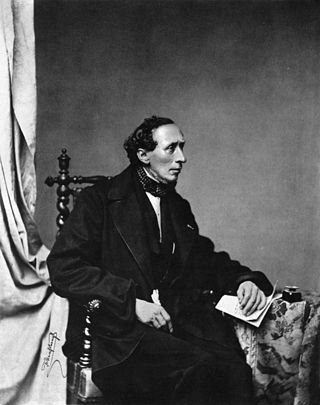
"The Snowman" is a literary fairy tale by Hans Christian Andersen about a snowman who falls in love with a stove. It was published by C.A. Reitzel in Copenhagen as Sneemanden on 2 March 1861. Andersen biographer Jackie Wullschlager describes the tale as a lyrical and poignant complement to Andersen's "The Fir-Tree" of December 1844.

Fairy Tales Told for Children. New Collection is a collection of ten fairy tales by Hans Christian Andersen. The tales were published in a series of three installments by C. A. Reitzel in Copenhagen, Denmark between October 1838 and December 1841.

The Crow is a Slavic fairy tale of Polish origin. Scholars relate it to the international cycle of the Animal as Bridegroom or The Search for the Lost Husband: a human maiden marries an animal that is a prince in disguise, breaks a taboo and loses him, and she has to seek him out.

An Old, Old Tale is a 1968 Soviet children's fantasy film directed by Nadezhda Kosheverova. It is based on four fairy tales by Hans Christian Andersen: "The Tinderbox", "The Travelling Companion", "The Swineherd" and "Blockhead Hans".


















